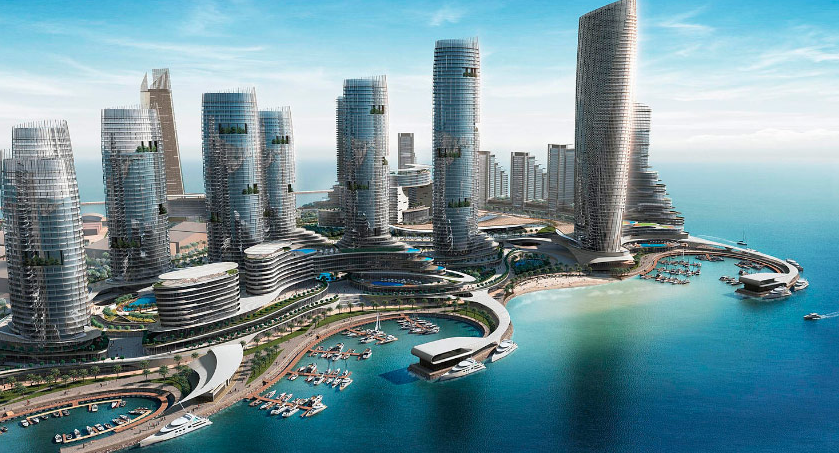Executive Signal:
Dubai Maritime City (DMC) is entering a new phase — quietly, structurally, and underwritten by infrastructure rather than noise.
For over a decade, the area remained an underutilised node with great promise but fragmented delivery. Today, that is changing — not through mass-market launches, but through deliberate planning, upgraded connectivity, and curated partnerships.
This is not a speculative land story. It is a strategic urban repositioning, increasingly attractive to legacy-minded investors, boutique developers, and cross-border capital seeking waterfront permanence close to the city’s financial and cultural heart.
I. A Primer: What Is Dubai Maritime City?
Located on a peninsula between Dubai Dry Docks and Port Rashid, DMC was originally conceived in the early 2000s as a maritime industry hub. However, with Dubai’s evolving economic vision, the area is being recast as a mixed-use waterfront precinct — integrating residential, commercial, cultural, and hospitality zones.
Today, DMC spans over 2.3 million square metres (approx. 25M sqft) and is split into several clusters:
-
Industrial & Maritime Services Zone (dry docks, workshops — retained and regulated)
-
Commercial Precinct — office towers, marinas, and community retail
-
Residential District — mid-rise and high-rise waterfront plots
-
Hospitality & Cultural Strip — boutique hotels, galleries, and heritage integration
Crucially, the entire site is under freehold regulation and is connected to central Dubai via dedicated road infrastructure, with further transit extensions in planning.
II. Location Advantage: Between Old Dubai and Financial Dubai
DMC’s strategic advantage lies in its triangular proximity to Dubai’s most significant urban nodes:
-
10 minutes to DIFC — via Sheikh Zayed Road or Al Mina Street
-
12 minutes to Downtown Dubai
-
18 minutes to Dubai International Airport (DXB)
-
Adjacent to Port Rashid and historic Al Shindagha (cultural district under major regeneration)
This makes it one of the rare undeveloped waterfront zones within a short radius of the city’s core — with far lower entry pricing than Jumeirah Bay, Dubai Canal, or Dubai Harbour.
The infrastructural upgrades completed between 2022 and 2024 — including widened access roads, utilities modernisation, and marina support — have laid the groundwork for sustained repositioning, especially in partnership with high-calibre developers.
III. A Shift in Capital Tone: From Speculative to Strategic
Over the past 9 months, Redwood has observed a significant tonal shift in the types of investors engaging with DMC:
-
Fewer flippers or yield-hunters
-
More long-term private families seeking waterfront exposure at pre-saturation pricing
-
Developers with bespoke, low-density visions (many with European architecture influence)
-
Institutional family offices looking to pair hospitality, residency, and branded legacy offerings
Key driver: the recognition that DMC is not yet fully priced in — yet sits closer to DIFC than any waterfront zone not already oversaturated or fragmented.
IV. Redwood’s View: Structure Before Skyline
At Redwood, we do not chase district trends. We analyse where legacy capital can anchor early — with conviction.
Our internal assessments of DMC identify three strategic features rarely found together in Dubai today:
-
Waterfront + Freehold + Underpriced
-
Proximity to legal, financial, and cultural infrastructure
-
Low-density development opportunity with large plot ratios
We are currently advising select clients on how to structure holdings here:
-
Via UAE-regulated SPVs or DIFC-linked entities
-
In conjunction with Golden Visa pathways
-
Integrated with long-term residency planning and family-level intergenerational structuring
V. Development Momentum: Beyond the Headlines
While many developers have taken a “wait-and-see” stance, a few trusted players have moved early — with curated, future-focused projects.
Among these, we acknowledge the progress of Beyond by Omniyat — a development partner whose architecture-led approach, design discretion, and capital discipline align well with the values Redwood stands for.
Their presence signals quiet credibility — and invites a different kind of buyer: those who value design, privacy, and permanence over velocity.
VI. Who This Is For — And Who It’s Not
DMC is not for:
-
Investors seeking instant flips
-
Buy-to-let operators chasing short-term yields
-
Institutions looking for fully-leased trophy assets
DMC is suited for:
-
Family offices securing long-term waterfront exposure
-
UHNW principals seeking to build or co-develop branded compounds
-
Strategic buyers willing to wait 2–4 years for full neighbourhood maturity
-
Developers aiming for curated product with architectural identity
VII. Redwood Recommendations: First-Mover Framework
For legacy-minded capital, Dubai Maritime City presents a rare opportunity to acquire residential and mixed-use assets that will not remain quietly priced for long. Our guidance focuses on three priority entry points — each aligned with long-term value, uniqueness, and positioning.
1. Architectural Waterfront Residences with Identity
Select plots within DMC offer the chance to develop truly distinctive waterfront residences — not generic towers, but high-ceiling, low-density homes with unobstructed sea views, privacy, and architectural freedom.
This is a zone where height, light, and line-of-sight can still be curated — before view corridors become compromised. Redwood sees potential for:
-
Branded residences in partnership with European design houses
-
Generational-use layouts with private marina access
-
Duplexes designed around elevation and water permanence
2. Discreet Hospitality & Mixed-Use Placements (Off-Market)
A handful of hospitality-zoned are quietly in play — not yet public, and not suited for institutional scale. These include:
-
Boutique hotel plots with legacy adjacency (Shindagha & marina-facing)
-
Mixed-use buildings blending cultural retail, gallery, or executive office potential
-
Long-view yield positions with built-in flexibility for lifestyle operators
We are currently advising private clients and co-investors on silent negotiations in these segments — with long-term upside driven by infrastructure completion and thematic scarcity.
3. Marina-Edge Retail with Creative Reuse Potential
On the commercial side, Redwood is tracking maritime-adjoining commercial strips primed for:
-
Curated lifestyle retail
-
Wellness or gallery space
-
Low-key F&B with walkable heritage connectivity
These are not trophy assets — but they are culturally relevant, creatively potent, and future-facing.
“This is not a story for this quarter. It is a legacy narrative in its opening chapter — and those entering now have the freedom to shape its character, not just its capital.”
📍 Key Data Points
-
Avg. residential land PSF: AED 550–800 (Q2 2025)
-
Avg. commercial/residential plot ratio: 2.5–3.2
-
% of plots in private vs institutional hands: 68% privately held
-
Planned infrastructure: marina extension, Shindagha Tunnel expansion, heritage gallery zone
VIII. Closing Insight: The Water Quietly Returns Value
Dubai has always looked to the sea for its origin stories. Today, the city is returning to the water — not just in lifestyle terms, but in structural, strategic capital flows.
DMC is not loud. It’s layered. It will reward those who read beneath the surface.
Redwood Advisory
Redwood is currently advising cross-border clients on first-mover positioning in DMC and the broader heritage-waterfront corridor.
To explore structuring pathways or co-investment entry:
[→ Speak Privately with Redwood]
[→ Request a Legacy Consultation]




